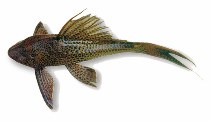| Family: |
Loricariidae (Armored catfishes), subfamily: Hypostominae |
| Max. size: |
24.98 cm SL (male/unsexed) |
| Environment: |
demersal; freshwater; brackish; pH range: 6.19999980926514 - 8.19999980926514; dH range: 28 |
| Distribution: |
South America: Guianas (coastal region from the Oyapock River basin to the Essequibo River basin). Identity of reported introduced species to several Asian countries for the aquarium trade need further confirmation. |
| Diagnosis: |
This species is distinguished by the following characters: differs from species of the H. cochliodon group (H. macushi and H. taphorni in the Guianas) by having viliform teeth (vs. large spoon-shaped teeth); differs from other Guianese species of Hypostomus by having teeth bearing a short roughly rounded crown, with lateral cusp about half the length of the main cusp (vs. an elongated crown, with a small lateral cusp in coppenamensis, corantijni, crassicauda, gymnorhynchus,nematopterus, watwata), or sometimes with an enlarged lateral cusp (observed in H. gymnorhynchus from upper Maroni River Basin only, H. micromaculatus and H. paucimaculatus); differs from long-crown toothed species except H. watwata by the presence of a preanal plate (vs. absence); differs from H. watwata in having an azygous plate which is sometimes divided into two to three secondary platelets, bordering the posterior part of the supraoccipital and directly contacting the pterotic-supracleithrum, laterally bordered by two plates that contact only the pterotic-supracleithrum (vs. an azygous plate, often divided anteriorly in small secondary platelets, not connecting the pterotic-supracleithrum, and with two lateral areas divided in multiple platelets, 4-13, bordering the postero-lateral part of the supraoccipital and the posterior part of the pterotic-supracleithrum (Ref. 90186). |
| Biology: |
This species inhabits the lower part of rivers still under tide influence, and characterized by a quiet flowing water and muddy substrate, and swamps (Ref. 90186). Feeds on algae and small crustaceans. Is cultured in ponds in Singapore and Hong Kong for the aquarium trade, where it is very popular (Ref. 2060). |
| IUCN Red List Status: |
Least Concern (LC); Date assessed: 14 February 2021 Ref. (130435)
|
| Threat to humans: |
harmless |
Source and more info: www.fishbase.org. For personal, classroom, and other internal use only. Not for publication.
